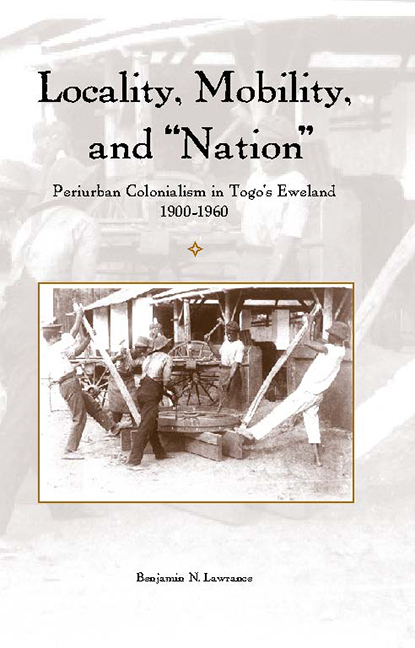Book contents
- Frontmatter
- Dedication
- Contents
- List of Illustrations
- Preface
- Notes on Orthography
- Map
- Introduction: Conceptualizing Periurban Colonialism in Sub-Saharan Africa
- 1 Mobility, Locality, and Ewe Identity in Periurban Eweland
- 2 Intervention and Dissent: Manufacturing the Model Periurban Chief
- 3 Crisis in an Ewe “Capital”: The Periurban Zone Descends on t he City
- 4 Vodou and Resistance: Politico-Religious Crises in t he Periurban Landscape
- 5 The German Togo-Bund and the Periurban Manifestations of “Nation”
- 6 From Eweland to la République Togolaise: Le Guide du Togo and the Periurban Circulation of Knowledge
- Epilogue
- Notes
- Bibliography
- Index
2 - Intervention and Dissent: Manufacturing the Model Periurban Chief
Published online by Cambridge University Press: 11 May 2017
- Frontmatter
- Dedication
- Contents
- List of Illustrations
- Preface
- Notes on Orthography
- Map
- Introduction: Conceptualizing Periurban Colonialism in Sub-Saharan Africa
- 1 Mobility, Locality, and Ewe Identity in Periurban Eweland
- 2 Intervention and Dissent: Manufacturing the Model Periurban Chief
- 3 Crisis in an Ewe “Capital”: The Periurban Zone Descends on t he City
- 4 Vodou and Resistance: Politico-Religious Crises in t he Periurban Landscape
- 5 The German Togo-Bund and the Periurban Manifestations of “Nation”
- 6 From Eweland to la République Togolaise: Le Guide du Togo and the Periurban Circulation of Knowledge
- Epilogue
- Notes
- Bibliography
- Index
Summary
Lomé may be the capital of Togo, but in Aného resides its heart.
—Attributed to Governor Auguste Bonnecarrère, ca. 1925 Interview with Hubert Kponton, 1971At a 1922 investiture ceremony for the chief (fia or fio) of Aného, song cards were circulated proclaiming Lawson the king of kings and the “supreme” leader of the Ewe “race.” This pomp and circumstance was part of a long struggle between two rival chiefly families, rooted in the precolonial period, that continues to this day. But the decision to invest Frederick Body Lawson V as paramount chief of Aného, one of the first administrative decisions taken by the French governor Auguste Bonnecarrère (in Togo, 1922–31), set the tone for the interventionist native policy characteristic of the French mandate. Lawson, who had had extensive communications with the French prior to the invasion of 1914, was a staunch French loyalist. He was also the most influential chief in southern Togo, and his early support for the French project was of inestimable value. The paramountcy in Aného, however, was very much an invention of Bonnecarrère, one that destabilized a delicate political balance between the rival Lawson and Adjigo-Gaba clans jostling for control of periurban farming, fishing, and commercial dividends. It is a story worthy of closer examination, for although the chiefly status and authority of Lawson were unparalleled, the decision was the harbinger of significant change among the periurban Ewe dukowo.
Chieftaincy or “stool” disputes offer exceptional vantage points from which social historians can unpack the details of the resource conflicts that reveal the inner workings of the colonial state. Stoolship disputes among Ewe dukøwo, moreover, have the added value of narrating the process of social conflict and political centralization that characterized the mandate period. The Lawson-Adjigo stoolship rivalry has all the makings of a classic resource dispute: two rival parties, each claiming suzerainty over the other and the wider Ewe periurban region; important economic resources, such as the collection of taxes and customs duties; colonial largesse from the tax-collection role; the trappings of chiefly and religious office; and even control over historical memory and settlement narratives.
- Type
- Chapter
- Information
- Locality, Mobility, and "Nation"Periurban Colonialism in Togo's Eweland, 1900–1960, pp. 45 - 68Publisher: Boydell & BrewerPrint publication year: 2007

